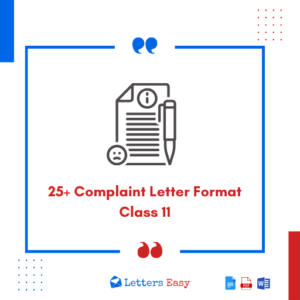17+ MLA Letter Format – Examples, Email Template, Wording Ideas
MLA Letter Format: The Modern Language Association (MLA) style is commonly used for academic writing in the humanities. MLA Cover letter format is a standard format used for writing formal letters in the MLA style. This article will provide guidelines and examples for MLA letter format.
Also Check:
- 10+ Letter Of Agency Requiring PCC Format Delhi PDF Examples
- 23+ CL Letter Format – Check Elements, Templates
- 25+ B Ed Internship Letter Format – Explore Writing Tips, Examples
MLA Letter Format Tips
Content in this article
General Guidelines:
- Use standard 8.5 x 11 inch paper for your Business letter.
- Use a legible font, such as Times New Roman or Arial, and a font size of 12.
- Use 1-inch margins on all sides of the page.
- Include a header with your name, instructor’s name, course title, and date in the upper left-hand corner of the first page.
- Use block format, meaning all text is left-aligned, with single-spacing within paragraphs and double-spacing between paragraphs.
- Include a closing and signature, and leave space for your signature and printed name.
Letter Components:
- Your Address: Type your name, address, phone number, and email address in the top right-hand corner of the page.
- Date: Skip a line and add the date under your address.
- Recipient’s Address: Skip another line and add the recipient’s name, title, organization or company, address, and city, state, and zip code.
- Salutation: Skip another line and add a salutation. If you don’t know the name of the person you’re writing to, use “Dear Sir or Madam.”
- Body: Skip another line and begin your letter with an introduction that briefly explains the purpose of your letter. The body of your MLA Letter Format should contain the main message you want to convey. Use clear and concise language and avoid using jargon or technical terms that your reader may not understand. You can also include any supporting evidence, such as data or examples, to strengthen your argument.
- Closing: Skip a line and add a closing, such as “Sincerely” or “Best regards.” If you’re writing to someone you know well, you can use a more informal closing, such as “Take care” or “Cheers.” Follow your closing with a comma.
- Signature: Skip four lines and include your handwritten signature. If you’re sending an electronic letter, you can use a digital signature.
- Printed Name: Skip two lines and type your full name.
MLA Letter Format – Sample Format
Below is a Sample Format of MLA Letter Format:
[Your Name]
[Your Address]
[City, State, ZIP Code]
[Email Address]
[Phone Number]
[Date]
[Recipient’s Name]
[Recipient’s Title, if applicable]
[Company or Institution Name]
[Address]
[City, State, ZIP Code]
Dear [Recipient’s Last Name],
[Opening Paragraph:]
Begin the letter with a formal salutation, such as “Dear Mr./Ms./Dr. [Last Name],”. If you have a specific title for the recipient, include it in the salutation.
[Body Paragraphs:]
Compose the body of the letter, ensuring that each paragraph is indented. Maintain a formal tone and structure, and use clear and concise language to convey your message.
[Closing Paragraph:]
Conclude the letter by summarizing your main points and expressing gratitude or goodwill. Use a closing phrase such as “Sincerely,” or “Yours faithfully,” followed by your signature.
[Your Full Name (Typed)]
[Your Signature, if sending a physical letter]
[Note: The above template provides a general outline for a formal MLA letter. Adjust the content and formatting based on the specific context and purpose of your letter.]
MLA Letter Format – Sample Format
MLA Letter Format – Example
Here’s an Example of MLA Letter Format:
[Your Name]
[Your Address]
[City, State ZIP Code]
[Date]
[Recipient Name]
[Recipient Address]
[City, State ZIP Code]
Dear [Recipient Name],
I am writing to express my interest in the position of [Job Title] that was recently advertised on [Source of the job advertisement]. I am a recent graduate of [Name of University] with a degree in [Your Field of Study], and I believe that my education and experience make me an ideal candidate for the role.
In addition to my academic background, I have gained valuable skills through internships and volunteer work in [Related Field]. I am particularly drawn to this position because [Reasons Why You Are Interested In This Position]. I am confident that my skills and experience make me a strong fit for the role.
Thank you for considering my application. I have attached my resume and references for your review. Please do not hesitate to contact me if you have any questions or need further information.
Sincerely, [Your Name]
MLA Letter Format – Example
Formal Letter in MLA Style
A template for crafting formal letters in MLA style, incorporating proper formatting, structured paragraphs, and appropriate salutations and closings for clear and professional communication.
[Your Name]
[Your Address]
[City, State, ZIP Code]
[Email Address]
[Phone Number]
[Date]
[Recipient’s Name]
[Recipient’s Title, if applicable]
[Company or Institution Name]
[Address]
[City, State, ZIP Code]
Dear [Recipient’s Last Name],
[Opening Paragraph:]
Begin the letter with a formal salutation, such as “Dear Mr./Ms./Dr. [Last Name],”. If you have a specific title for the recipient, include it in the salutation.
[Body Paragraphs:]
Compose the body of the letter, ensuring that each paragraph is indented. Maintain a formal tone and structure, and use clear and concise language to convey your message.
[Closing Paragraph:]
Conclude the letter by summarizing your main points and expressing gratitude or goodwill. Use a closing phrase such as “Sincerely,” or “Yours faithfully,” followed by your signature.
[Your Full Name (Typed)]
[Your Signature, if sending a physical letter]
[Note: This format adheres to the MLA style for formal letters. Ensure that you follow any specific guidelines provided by your institution or publication.]
Formal Letter in MLA Style
MLA Friendly Letter Format
The Modern Language Association (MLA) does not provide specific guidelines for friendly letters, as it mainly focuses on academic writing. However, you can follow a general friendly letter format with informal language, maintaining clarity and friendliness:
[Your Name]
[Your Address]
[City, State, ZIP Code]
[Email Address]
[Phone Number]
[Date]
[Recipient’s Name]
[Recipient’s Address]
[City, State, ZIP Code]
Dear [Recipient’s First Name],
[Opening Paragraph:]
Begin the letter with a warm greeting, mentioning your relationship or any shared experiences.
[Body Paragraphs:]
Share your news, stories, or any relevant information. Keep the tone casual and friendly, allowing your personality to shine through.
[Closing Paragraph:]
Wrap up the letter with a friendly closing, expressing anticipation for future communication or sharing plans to meet.
Best regards,
[Your Full Name]
Remember, the key to a friendly letter is to maintain a warm and approachable tone while following basic letter-writing conventions.
MLA Friendly Letter Format
MLA Letter Format – Template
This is a Template of MLA Letter Format:
[Your Name]
[Your Address]
[City, State ZIP Code]
[Date]
[Recipient Name]
[Recipient Address]
[City, State ZIP Code]
Dear [Recipient Name],
I am writing to request an extension on the deadline for my [Name of Assignment] assignment. Due to unforeseen circumstances, I have been unable to complete the assignment on time, and I am hoping to request an extension until [New Deadline Date].
I understand that this may cause inconvenience, and I apologize for any inconvenience that this may cause. I assure you that I will use the additional time to ensure that the assignment is of the highest quality.
Thank you for your understanding. Please let me know if you require any further information or documentation.
Sincerely, [Your Name]
MLA Letter Format – Template
MLA Style Letter to a Professor
A template for crafting a formal letter to a professor in MLA style, ensuring a respectful tone, clear structure, and adherence to academic conventions.
[Your Name]
[Your Address]
[City, State, ZIP Code]
[Email Address]
[Phone Number]
[Date]
[Professor’s Full Name]
[Department]
[University Name]
[University Address]
[City, State, ZIP Code]
Dear Professor [Last Name],
[Opening Paragraph:]
Begin with a formal salutation, addressing the professor respectfully, such as “Dear Professor [Last Name],”.
[Body Paragraphs:]
Compose the body of the letter, maintaining a formal tone and structure. Clearly state the purpose of your letter and provide any necessary context or details.
[Closing Paragraph:]
Conclude the letter by expressing gratitude and including a closing phrase such as “Sincerely,” or “Yours faithfully,” followed by your signature.
[Your Full Name (Typed)]
[Your Signature, if sending a physical letter]
[Note: Follow specific guidelines provided by your educational institution for any additional details or requirements for communication with professors using MLA style.]
MLA Style Letter to a Professor
MLA Format for Application Letter
A structured template for an application letter in MLA format, designed for clarity and professionalism in presenting qualifications and intentions for a job or academic position.
[Your Name]
[Your Address]
[City, State, ZIP Code]
[Email Address]
[Phone Number]
[Date]
[Employer’s Name]
[Company Name]
[Company Address]
[City, State, ZIP Code]
Dear [Employer’s Last Name],
[Opening Paragraph:]
Begin the letter with a formal salutation, such as “Dear Mr./Ms./Dr. [Last Name],”.
[Body Paragraphs:]
Compose the body of the letter, ensuring each paragraph is indented. Clearly state the purpose of your application, highlight your qualifications, and express your interest in the position.
[Closing Paragraph:]
Conclude the letter by summarizing your main points, expressing enthusiasm for the opportunity, and using a closing phrase such as “Sincerely,” or “Yours faithfully.”
[Your Full Name (Typed)]
[Your Signature, if sending a physical letter]
[Note: Adapt the content based on the specific requirements of the job application and follow any additional guidelines provided by the employer or institution.]
MLA Format for Application Letter
MLA Recommendation Letter
A template for crafting a recommendation letter in MLA format, designed to convey a professional and detailed endorsement of an individual’s capabilities and attributes.
[Your Name]
[Your Address]
[City, State, ZIP Code]
[Email Address]
[Phone Number]
[Date]
[Recipient’s Full Name]
[Title, if applicable]
[Institution or Company Name]
[Address]
[City, State, ZIP Code]
Dear [Recipient’s Last Name],
[Opening Paragraph:]
Begin the letter with a formal salutation, such as “Dear Mr./Ms./Dr. [Last Name],”.
[Body Paragraphs:]
Compose the body of the letter, maintaining a formal tone and structure. Clearly state your recommendation for the individual, providing specific examples of their qualifications, skills, and character.
[Closing Paragraph:]
Conclude the letter by summarizing the individual’s strengths and expressing confidence in their abilities. Use a closing phrase such as “Sincerely,” or “Yours faithfully.”
[Your Full Name (Typed)]
[Your Signature, if sending a physical letter]
[Note: Follow specific guidelines provided by the institution or employer regarding the content and formatting of recommendation letters in MLA style.]
MLA Recommendation Letter
Email Format about MLA Letter format
Here’s an Email Format for MLA Letter Format:
Subject: MLA Letter Format
Dear [Recipient’s Name],
I hope this email finds you well. I am writing to inquire about the proper MLA letter format for my upcoming assignment/job application. I am aware that MLA is mostly associated with academic writing, but I was informed that it is also appropriate for letter writing.
Could you please provide me with some guidelines or a sample of an MLA letter format that I can follow? I would greatly appreciate any assistance you can provide.
Thank you in advance for your time and help. Please let me know if you require any further information from me.
Best regards,
[Your Name]
Email Format about MLA Letter Format
MLA Resignation Letter
A template for creating a resignation letter in MLA format, ensuring a clear and respectful expression of your decision to resign and gratitude for the opportunities during your tenure.
[Your Name]
[Your Address]
[City, State, ZIP Code]
[Email Address]
[Phone Number]
[Date]
[Recipient’s Name]
[Company Name]
[Company Address]
[City, State, ZIP Code]
Dear [Recipient’s Last Name],
[Opening Paragraph:]
Begin with a formal salutation, such as “Dear Mr./Ms./Dr. [Last Name],”.
[Body Paragraphs:]
Compose the body of the letter, maintaining a formal tone and structure. Clearly state your intention to resign from your position, provide the effective date of your resignation, and express gratitude for the opportunities.
[Closing Paragraph:]
Conclude the letter by expressing appreciation for the experience gained and offering assistance during the transition. Use a closing phrase such as “Sincerely,” or “Yours faithfully.”
[Your Full Name (Typed)]
[Your Signature, if sending a physical letter]
[Note: Follow specific guidelines provided by your company and ensure that the content of the letter aligns with professional standards.]
MLA Resignation Letter
MLA Acknowledgment Letter
A template for drafting an acknowledgment letter in MLA format, designed to convey appreciation and recognition formally, adhering to clear and organized communication standards.
[Your Name]
[Your Address]
[City, State, ZIP Code]
[Email Address]
[Phone Number]
[Date]
[Recipient’s Full Name]
[Title, if applicable]
[Institution or Company Name]
[Address]
[City, State, ZIP Code]
Dear [Recipient’s Last Name],
[Opening Paragraph:]
Begin the letter with a formal salutation, such as “Dear Mr./Ms./Dr. [Last Name],”.
[Body Paragraphs:]
Express your gratitude and acknowledgment in a formal tone. Clearly state the purpose of the acknowledgment, providing any necessary details.
[Closing Paragraph:]
Conclude the letter by summarizing the acknowledgment and expressing appreciation. Use a closing phrase such as “Sincerely,” or “Yours faithfully.”
[Your Full Name (Typed)]
[Your Signature, if sending a physical letter]
[Note: Adapt the content based on the specific acknowledgment being made and follow any additional guidelines provided by the institution or organization.]
MLA Acknowledgment Letter
MLA Thank You Letter
A template for creating a thank-you letter in MLA format, designed to convey appreciation in a formal and organized manner, adhering to the principles of MLA style for clear and effective communication.
[Your Name]
[Your Address]
[City, State, ZIP Code]
[Email Address]
[Phone Number]
[Date]
[Recipient’s Full Name]
[Title, if applicable]
[Institution or Company Name]
[Address]
[City, State, ZIP Code]
Dear [Recipient’s Last Name],
[Opening Paragraph:]
Begin with a formal salutation, such as “Dear Mr./Ms./Dr. [Last Name],”.
[Body Paragraphs:]
Express your gratitude in a formal tone. Clearly state the purpose of the thank-you letter and provide specific details about why you are grateful.
[Closing Paragraph:]
Conclude the letter by summarizing your appreciation and expressing thanks again. Use a closing phrase such as “Sincerely,” or “Yours faithfully.”
[Your Full Name (Typed)]
[Your Signature, if sending a physical letter]
[Note: Tailor the content based on the specific context and reason for expressing thanks. Follow any additional guidelines provided by the institution or organization.]
MLA Thank You Letter
FAQS for MLA Letter Format – Examples, Email Template, Wording Ideas
How do I format a letter in MLA style?
Ensure your MLA Letter Format follows MLA conventions, including proper heading, salutation, body paragraphs with indentation, and a formal closing.
Can I use MLA Letter Format for email correspondence?
While MLA Letter Format is primarily for academic writing, you can apply its principles to emails by incorporating proper formatting and maintaining a professional tone.
Are there specific guidelines for addressing recipients in MLA Letter Format?
Yes, This MLA Letter Format address recipients formally using titles (Mr., Ms., Dr.) and include their last name in the salutation (e.g., “Dear Dr. Smith”).
What is the recommended font and size for MLA Letter Format?
Use a legible font like Times New Roman or Arial, size 12, for MLA Letter Format to ensure readability and adherence to MLA style.
Can I include bullet points or lists in An MLA Letter Format?
MLA Letter Format generally prefers narrative writing, but if the content benefits from lists, use clear and concise bullet points, ensuring they follow MLA conventions for formatting.
MLA Letter Format is a standard format used for writing formal letters in the MLA style. By following the guidelines and examples provided in this article, you can write a clear and concise letter that conveys your message effectively.






